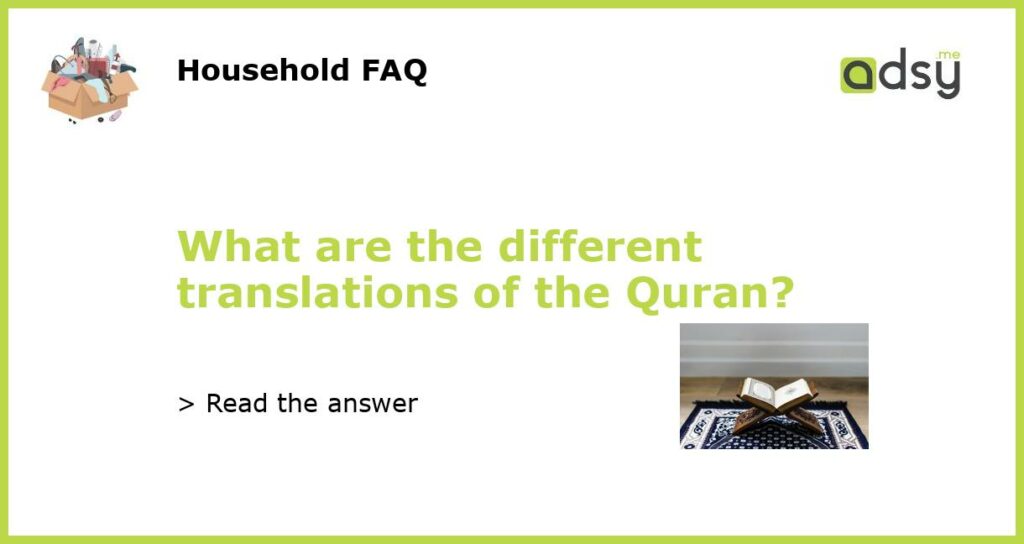The Different Translations of the Quran
For Muslims around the world, the Quran is the holy book that contains the divine revelation from Allah. The Quran was originally written in Arabic, but due to its significance and influence, it has been translated into many different languages. These translations aim to enable non-Arabic speakers to understand and connect with the teachings of the Quran. In this article, we will explore the different translations of the Quran and their significance.
The Importance of Translations
The translation of the Quran plays a crucial role in making its teachings accessible to a wider global audience. By translating the Quran into different languages, people who do not speak or understand Arabic can still engage with its messages, concepts, and lessons. Translations allow Muslims, as well as non-Muslims, to gain a deeper understanding of the Quran’s wisdom and guidance, fostering greater interfaith dialogue and understanding.
Early Translations of the Quran
One of the earliest translations of the Quran was done during the time of Prophet Muhammad himself, in order to spread the message of Islam to other tribes and communities. However, these early translations were not as comprehensive as the ones we have today and were mainly carried out to facilitate the understanding of specific verses or passages.
The first complete translations of the Quran into other languages were made centuries later. One of the most notable early translations was carried out by Salman the Persian in the 9th century. This translation was into the Persian language and is considered to be one of the earliest complete translations.
Prominent Translations of the Quran
Throughout history, numerous scholars and linguists have undertaken the task of translating the Quran into different languages. Some of the most prominent translations include:
– The Abdullah Yusuf Ali translation: This is one of the most widely known and utilized translations of the Quran. It was completed by the Indian-born scholar Abdullah Yusuf Ali in the early 20th century and is often recognized for its extensive footnotes and explanations. This translation is available in multiple languages, making it accessible to a wide range of readers.
– The Muhsin Khan translation: Another popular translation is the one completed by Muhammad Taqi-ud-Din al-Hilali and Muhammad Muhsin Khan in the 20th century. Known as “The Noble Quran,” it is widely used by English-speaking Muslims around the world. This translation includes parenthetical explanations within the text for better comprehension.
– The Saheeh International translation: This translation is known for its modern language and clarity. It was completed by a team of scholars with the goal of making the meanings of the Quran more understandable to contemporary readers. The Saheeh International translation is widely available in various languages and is utilized by Muslims globally.
Translation Challenges and Controversies
Translating the Quran is not merely a linguistic exercise; it involves conveying the subtle meanings, nuances, and poetic beauty of the original Arabic text. As a result, there are often challenges that arise in the process of translation.
Some of the challenges include:
– Literal vs. Interpretative translations: Translators often face the dilemma of whether to provide a word-for-word literal translation or an interpretation that captures the overall meaning of the text. Striking a balance between these approaches is crucial to maintain accuracy and comprehension.
– Cultural and historical contexts: The Quran was revealed in a specific historical and cultural context, and translating its message into a different time and culture can be complex. Understanding the context and ensuring that the translation is relevant and relatable to the target audience is a significant challenge for translators.
Controversies around translations can also arise due to differences in theological understandings and interpretations. Some translations may incorporate interpretative commentary, which can lead to disagreements among scholars and readers.
The Influence of Translations
The translations of the Quran have had a profound impact on the spread and understanding of Islam worldwide. They have played a significant role in introducing the teachings of Islam to non-Arabic speakers and promoting interfaith dialogue. Translations have allowed Muslims and non-Muslims alike to explore the profound wisdom and guidance of the Quran, fostering a deeper understanding among diverse communities.
Furthermore, translations have enabled Muslims living in non-Arabic speaking countries to engage with the Quranic teachings in their native language, allowing for a more personal and meaningful connection with the scripture. This has contributed to the cultural and linguistic diversity of Islamic practice and scholarship.
In conclusion, the translations of the Quran have played a vital role in making its teachings accessible to a global audience. They have allowed Muslims and non-Muslims to engage with the Quran’s wisdom and message, fostering greater understanding and interfaith dialogue. However, the challenges and controversies surrounding translations highlight the complexities involved in conveying the nuances and meanings of the Quran’s original Arabic text. Despite these challenges, translations continue to have a profound influence on the understanding and practice of Islam in diverse communities around the world.






